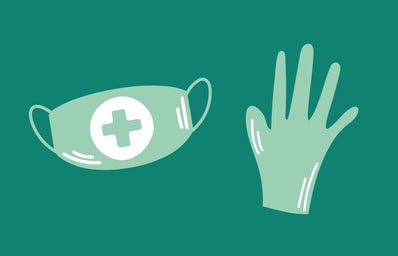“Maybe while you’re in school, you can just meet a nice doctor to marry instead,” my grandma told me over Thanksgiving dinner my freshman year of college. I quickly retorted,”Nanny, the only doctor I’m going to meet in Morgantown is my future self.”
While I’d like to give my eldery grandmother the benefit of the doubt over her comment several years ago, I can’t help but acknowledge the sexist undertones. Sure, she, like many other aging people are “from a different time” when female physicians were few and far between. Back then, the most dignified healthcare position a woman could readily achieve was as a nurse, but more and more women are entering the healthcare realm as doctors now than ever before. In 2019, the Association of American Medical Colleges (AAMC) reported that for the first time ever, the majority of medical students are female. In the same report, the AAMC showed that medical schools are becoming more diverse in terms of race and ethnicity as well as gender— a small but exciting step for those looking to pursue the profession. Is the potential these statistics show for a more diverse medical field enough to uproot the deeply held sentiments about what a doctor should look like?
More and more female physicians are speaking up about their own experiences in medicine, revealing just how massive this issue is. In her article, “Sexism in Medicine” Dr. Jane Grant-Kels reacts to a recently published article by Dr. Allyson Herbst, a resident physician in internal medicine on clinical rotations in New York. Dr. Allyson Herbst describes the inappropriate locker room talk male physicians have with one another in the operating room, making comments during surgery such as “splay it open like a Russian whore” in reference to an exposed hepatoduodenal ligament, to name one such example. Dr. Grant-Kels shares her own “war story” from her time in medical school in the early 1970’s: “Although I am confident that other female physicians in my age cohort all have similar war stories, there is one in particular that I would like to share. Months after giving birth to my first child, a stillborn son, I became pregnant again. In my seventh month, I visited my future fellowship director to inform him that I would arrive in my ninth month but did not plan to take time off other than my allotted vacation time. Despite him knowing my history, he became quite angry. His words still echo in my memory: ‘How dare you get pregnant on me! Women in academics who have children are of no use to me.’” These sexist interactions involving female physicians not only exist amongst them and their colleagues, but also extend to their patients.
Not only are female physicians mistaken for nurses, referred to as a pet name instead of their professional titles, or even overlooked as a physician if males are present, but they are also targets of microaggressions and sexual harassment by patients. The AAMC reports that in 1993, up to 75% of female doctors were sexually harassed by patients and in 2014, nearly 60% of medical trainees had experienced at least one form of sexual harassment/discrimination during their medical training by patients and/or patients’ family members. The behaviors considered as sexual harassment included crotch-grabbing and unwelcome touch, repeatedly asking for a date, and more in the form of subtle as well as overt inappropriate sexual remarks. Many of these incidents with patients are chalked up as part of the job and not reported despite the inappropriateness and severity of the situations. Reporting these incidents, being vocal about inappropriate behavior, and refusing to allow sexual harassment to be ignored or swept under the rug are the best tactics female physicians and their male colleagues have to prevent these incidences from being frequent occurrences.
Female physicians regularly experience the more overt forms of harassment based on sex and gender than their male colleages. Petty comments and sexist remarks occur weekly— if not daily— and are difficult to react to in the fast-paced healthcare realm. In regards to more subtle microaggressions on the basis of sex or gender, an article by Dr. Fizza Manzoor provides strategies female physicians can utilize when they’re mistaken for nurses— a common microaggression women in healthcare face.
Manzoor starts by describing a hypothetical female physician’s morning beginning bedside rounds and then segways into her strategies: “One weekday afternoon, you begin bedside patient rounds after listening to a seminar on ‘Women in Medicine’: in your opinion, a somewhat antiquated topic in the new era of modern, equitable health care. The routine is predictable yet impressive as you weave from room to room: a thoughtful greeting, an attentive inquiry about symptoms, an elegant physical examination…As you head toward the door, the patient asks, ‘Nurse, can you get me another blanket?’”
“This interaction is frustrating, but is no surprise for female physicians who are repeatedly mistaken for nurses or other health care professionals,” Manzoor says. “Examples of other patronizing, gender-stereotyping comments from patients include calling female doctors ‘honey’ or ‘sweetie,’ viewing young female physicians as inexperienced, asking intrusive personal questions and tacitly presuming men are physicians. The persistence of sexism despite rising female representation indicates that professional membership alone is insufficient. Systemic change is underway, but why wait in silent bitterness? Here, we offer 7 strategies for the physician who finds herself, once again, mistaken for a nurse.”
Manzoor goes on to list her seven strategies in a chart with examples, ranging from “blunt efficiency,” where the female physician addresses misguided comments promptly to “collegial humor,” where she instead forgives the comment and jokes about the awkwardness. Regardless of which route is chosen, they all accomplish the same goal of correcting the sexist comment and validating the female doctor’s role in the healthcare process.
While it is frustrating for female doctors to have to continually prove themselves to not only their peers and superiors but also their patients, it seems that these disrespectful and sexist occurrences will continue to occur so long as they are allowed. Female and male physicians alike have to be involved and present as a united force to overturn this antiquated way of thinking and create a platform for female physicians in medicine to be treated with the respect and dignity they deserve. Calling out inappropriate behaviors and comments when witnessed, giving female physicians credit when credit is due and being mindful of your own potential microaggressions are just a few examples of tactics supporters of women in medicine can use. This treatment of female physicians is just one more obstacle to overcome in reaching gender equality— one that will require support and patience to change the way many people think. Change like this is inevitable, but not impossible. George Bernard Shaw phrases this nicely with his famous quote, saying, “Progress is impossible without change, and those who cannot change their minds cannot change anything.” Past female physicians have defied odds and demonstrated resilience to practice medicine in a society where they may not receive the credit nor recognition they deserved. To honor these women for the struggle they faced, let’s ensure that future female doctors do not have to bear the same cross, so that they too can be respected as Dr., not Mrs.


